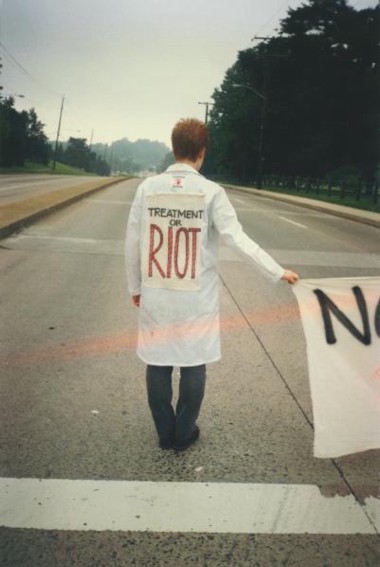Autumn in New England is scarf season, and, like most people, I’ve built up a collection over the years. Most of them, to be honest, I don’t remember buying—they were probably gifts, or maybe left behind by a friend of a friend at some dinner party the year before. Like falling leaves, they seem to accumulate before you know what’s happening.
Among them is a scarf my mother gave me a few years ago. It’s not the most comfortable scarf I own—it’s a little thicker than I’d like, and the length is all wrong—but I find myself wearing it as often as not, mostly because of a small equals sign that decorates one end. Yellow on a purple ground, it’s the icon of the Human Rights Campaign, an advocacy group fighting for lesbian, gay, bisexual and transgender rights equality. As it happens, I’m not gay—but my mom is, and wearing that scarf makes me feel closer not only to her but to a wider community where it’s hoped that common decency and compassion will be the rule instead of the exception.
I was thinking about her, and her history of activism, when I saw that How To Survive A Plague was playing at Amherst Cinema this week. A documentary look at the history of two early AIDS activist movements—ACT UP and TAG (Treatment Action Group)—this is a film that proves that true power lies not in numbers but in passion. At its heart is a small band of people furiously fighting for their own lives, and having to fight others just for the chance to live; they were some of the earliest people with AIDS, trying to survive at a time when the ER at St. Vincent’s Hospital barred them from entry.
It’s almost difficult to remember now what that time was like. Suffused with a creeping fear of a still misunderstood disease, public panic threatened to overwhelm the people who most needed help. Too often, it did. (One piece of film shows members of ACT UP dumping ashes and bone fragments of victims onto the White House lawn.) But even in the face of the most hopeless times, there were those whose outrage was loud enough to be heard. And while AIDS and HIV have never, ever been the “gay disease” so many tried to make it out to be, it is certainly the gay community whose fierce activism deserves our thanks: today over 6 million people have been saved using the drug therapies pioneered by ACT UP. Compared to that, my scarf seems more than a little ridiculous—but it makes me all the more proud to wear it.
*
Also this week: Halloween is right around the corner, and Hadley’s Cinemark Theater is getting into the spirit with a pair of shows that give you fright two ways: straight up or with a comedy twist. First on the schedule is John Carpenter’s 1978 chiller Halloween, screening Oct. 25 at 7 and 9:30 p.m. For my money, Halloween was always a scarier ride than the Friday the 13th series that followed, largely due to the blank white rubber mask worn by escaped killer Michael Myers. A bit of movie trivia: the mask used in the first two Halloween films was actually a repurposed mask pulled from the Star Trek effects studio; it’s really an altered Captain Kirk mask, which somehow makes the whole thing scarier still.
If you prefer your thrills with a bit of laughter, try Young Frankenstein, screening on Halloween at 2 and 7 p.m. The Mel Brooks classic is a grand spoof of Mary Shelley’s monster tale, starring Gene Wilder as the grandson of the infamous mad doctor. After years spent trying to distance himself from the family history, young Frankenstein finds himself drawn to create life, much as his grandfather was—but the life he creates is nothing like the monsters that came before. This giant (played by Everybody Loves Raymond dad Peter Boyle) tap dances, among other things. The film is greatly helped by one of the all-time best supporting casts: above all, keep an eye out for Marty Feldman’s Igor.•
Jack Brown can be reached at cinemadope@gmail.com.



